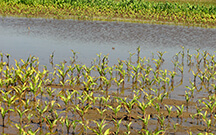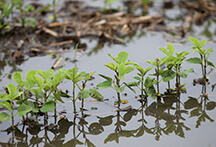About $300 million in Indiana crops' value lost to flooding so far
June 26, 2015
 |
|
Jay County in eastern Indiana was hit with a deluge of rain during the week of June 22, as this flooded cornfield shows. (Purdue Agricultural Communication photo/Darrin Pack) |
INDIANAPOLIS, Ind. - Torrential rains and resulting flooding have destroyed as much as 5 percent of Indiana's corn and soybean crops and potentially have caused about $300 million in crop damage since the beginning of June, Purdue Extension economist Chris Hurt said Friday (June 26).
"We went from a well above-normal crop to a very discouraging, below-normal crop," he said at a special news briefing at the Indiana State Fairgrounds. "This was a very devastating period."
He expects the losses to continue to mount at least over the next few weeks as more rain is forecast.
Hurt said grain prices were starting to increase as the extent of the crop damage became apparent. But the higher prices could be offset by reduced yields and increased expenses from replanting flood-damaged fields.
"There are very major reasons for concern," Hurt said.
Michael Langemeier, an agricultural economist specializing in crop systems, said about 80 percent of the state's corn and soybean acreage was covered by crop insurance. Although it is too late to consider replanting corn, soybean farmers could decide to start over with reduced insurance coverage. During a late planting period that ends July 15, coverage drops 1 percent per day.
Langemeier said farmers need to do a cost-benefit analysis before deciding whether to replant.
"The main things farmers need to consider is what additional expenses I will incur and compare that to the additional revenue," he said.
Julia Wickard, state executive director of the Farm Service Agency, said Indiana has not yet applied for federal disaster assistance.
"We certainly know that our farmers across Indiana are experiencing unprecedented rainfall," she said. "These flood events have left damage and heartbreak behind."
 |
|
A row of recently planted soybeans is surrounded by water in a Tippecanoe County field flooded by frequent rains over the past two weeks. (Purdue Agricultural Communication photo/Tom Campbell) |
She said FSA officials were collecting data and assessing damage in the hardest-hit parts of the state. To qualify for disaster assistance, such as low-interest loans, a region has to show at least a 30 percent loss in production.
"We are ready to take on this challenge that will probably be confronting us as we move forward," she said.
Ken Scheeringa, associate state climatologist, said the region's unsettled weather would likely continue for at least the next month, with conditions cooler and wetter than normal.
"Even though there is a very good chance for above-average rainfall, I am hopeful the amounts will be more reasonable," Scheeringa said.
Other speakers, with highlights of their flood and crops updates:
* CORN, Bob Nielsen, corn specialist: Although a wet spring planting season is not unusual in the eastern Corn Belt "what is clearly different this year is the magnitude of it." The June rains have affected several hundred thousand acres, perhaps as much as in 30 years. It is too late to replant damaged acreage. Despite the damage, there are signs of improvement. Yield potential of the crop will depend largely on the weather over the next 2-3 weeks.
* SOYBEANS, Shaun Casteel, soybean specialist: Although conditions for planting were marginal to begin with, the positive development is that there has been enough moisture to allow root systems to grow through compacted soil. Nitrogen loss has gone well beyond normal, so plants will need "a shot in the arm" with additional nitrogen when conditions warrant. For new planting or replanting, farmers will need to use varieties that will allow for a mature crop by fall harvest after a shortened growing season.
* WEEDS, Bill Johnson, weed scientist: Farmers should get weeds under control with respraying as soon as fields dry out but should not feel rushed in windy conditions. They also will need to understand the risks of making "off-label" herbicide applications. Farmers wanting to plant soybeans in fields where drowned-out corn was planted should understand that some commonly used corn herbicides do not allow soybeans to be planted in the same year.
* INSECTS, Christian Krupke, professor of entomology: A "silver lining" to the rain is that corn rootworm, the most common pest in the growing season, is highly susceptible to drowning. So many of them have died off. There is uncertainty whether aphids, a common pest for soybeans, will be a problem this year. That is because Indiana does not have enough history of planting soybeans in July to predict whether there will be infestations.
* DISEASES, Kiersten Wise, associate professor of plant pathology: Although there is uncertainty about diseases at this time, saturated soils could create conditions suitable for soybean sudden death syndrome and, especially in northern counties, white mold. Corn foliar diseases such as northern leaf blight are starting to show in some fields.
* NUTRIENT MANAGEMENT, Jim Camberato, soil fertility specialist: Farmers will need to assess how much nitrogen their crops have lost and consider supplemental applications. Those who have been unable to apply nitrogen will need to assess the plants' root system and make the difficult decision about how much to apply.
* COVER CROPS, Eileen Kladivko: Farmers who have been unable to plant or who have severely damaged fields should consider planting a cover crop to rebuild the soil's productive properties and minimize weeds. Farmers who already have applied an herbicide to corn, however, might have fewer choices of cover crops to use effectively.
* FORAGES, Keith Johnson, forage specialist: It critical to monitor temperature of stored forages so that their temperature does not exceed 150 degrees Fahrenheit. Typical temperature is 120 degrees or less. Also, make sure soil is dry enough to accommodate harvesting equipment.
* DISASTER ASSISTANCE, Steve Cain, Extension Disaster Education Network homeland security project director: No Federal Emergency Management Agency disaster declaration is expected, so communities must recover from flooding without federal financial assistance. EDEN is assisting those in heavily flooded areas, such as White and Jasper counties, especially hit hard with residential damage. Also, EDEN has resources for owners of flood-damaged homes in the Extension publication First Steps to Flood Recovery.
Writers: Darrin Pack, 765-494-8415, dpack@purdue.edu
Keith Robinson, 765-494-2722, robins89@purdue.edu
Sources: Chris Hurt, 765-494-4273, mailto:hurtc@purdue.edu
Julia Wickard, Julia.wickard@in.usda.gov
Mike Langemeier, 765-494-9557, mlangeme@purdue.edu
Ken Scheeringa, 765-494-8105, kens@purdue.edu
Bob Nielsen, 765-494-4802, rnielsen@purdue.edu
Shaun Casteel, 765-494-0894, scasteel@purdue.edu
Keith Johnson, 765-494-4800, johnsonk@purdue.edu
Bill Johnson, 765-494-4656, wgj@purdue.edu
Christian Krupke, 765-494-4912, ckrupke@purdue.edu
Kiersten Wise, 765-496-2170, kawise@purdue.edu
Jim Camberato, 765-496-9338, jcambera@purdue.edu
Eileen Kladivko, 765-494-6372, kladivko@purdue.edu
Steve Cain, 765-494-8410, cain@purdue.edu
Ag Communications: (765) 494-2722;
Keith Robinson, robins89@purdue.edu
Agriculture News Page

